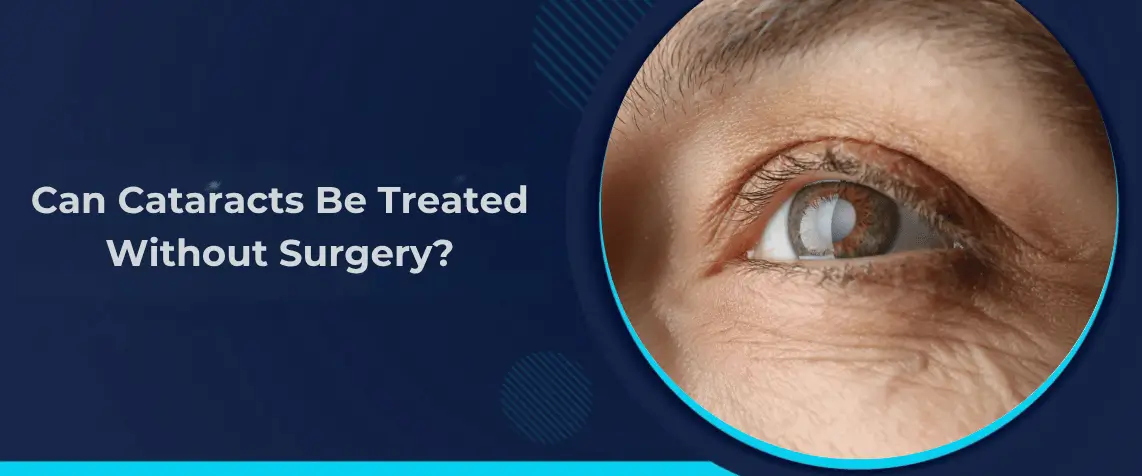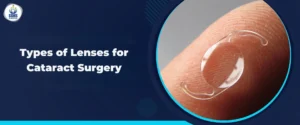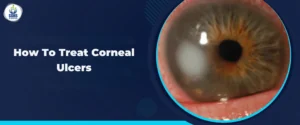Highlights
- Cataract is an eye condition associated with blurring of the natural eye lens; resulting in foggy vision.
- Cataract prevention steps include wearing sunglasses, eating a healthy diet, and quitting smoking.
- Cataract symptoms cause blurry vision, light sensitivity, poor night vision, faded colours, double vision, and frequent changes in prescription glasses.
- In the initial cataract stages, prescription glasses and lifestyle changes may help you see better, while in the advanced stages, surgery is the best option as of now.
- Cataract surgery is one of the most successful procedures the world over. It’s safe, fast, painless, and gives long-lasting clear vision.
Wondering – Can cataract be treated without surgery? Let’s see!
What are Cataracts?
Before discussing treatment options, let us understand what exactly are cataracts. The lens of a normal eye is like a clear window that allows light to pass, so that you see sharp and clear images. When cataracts occur, this window becomes foggy or cloudy. The result is blurred vision, making it hard to see clearly and perform routine tasks.
Prevention is Better than Cure
The power of prevention cannot be overstated. While it may not always be possible to steer clear of cataract, we can at least try to mitigate the risk. Here are some ways:
- Wear sunglasses as protection against damaging UV rays of the sun
- Consume an antioxidant-rich diet
- Refrain from smoking
What are the Symptoms of Cataract?
Blurred Vision
If you can no longer see things clearly, and images are no longer sharp and distinct but cloudy or fuzzy, it could be an indication of cataracts.
Light Sensitivity
If you cannot bear bright light any more, whether it is daylight or glaring, harsh lights, it is another sign of cataracts.
Poor Night Vision
Find it difficult to see in low light conditions? Wondering about that ever-increasing need for better-lit environments? Well, it could be due to cataracts.
Yellowed Colours
When colours seem to lose their true hues and turn dull, like a bit washed out or faded, it could signal cataracts.
Double Vision
Double vision or diplopia is yet another sign of cataracts. The clouded eye lens scatters the light falling on it, making you see overlapping images or two of everything.
Glasses Prescription Changes Often
Had stable eye power for some time? But now, you have been changing glasses frequently. As the eye lens turns cloudier over time, your eyesight may go on diminishing, necessitating you to get new specs more often.
Halos Around Lights
Have you lately started seeing halos around street lights and headlights of vehicles? Cataracts cause patients to see halos by scattering light as it enters the eye.
What Non-Invasive Alternatives are Available?
Although surgery continues to be the gold-standard for cataract treatment, a few non-surgical options are worth-considering, more so in the initial stages of the condition:
Lifestyle Modifications
Sticking to a healthy lifestyle can work wonders in preventing cataracts from advancing. So, get moving, fill your plate with leafy greens and colourful fruits, and no more indulging in unhealthy habits.
Prescription Eyewear
We earlier said that eye power witnesses frequent changes when you have cataract. Right prescription glasses are very much a part of the solution to help you see clearly.
Under Research Treatments
Researchers have long been exploring novel approaches to manage and treat cataracts without surgery. These potential treatment options range from eye drops and laser treatments to utilising ultrasound technology.
However, as of now, although we do hear of revolutionary cataract treatments like Lanosterol and Can-C eye drops as well as nutritional therapies, none of them has US-FDA approval. This means they may be available in the market, but we cannot be sure of their safety aspect and effectiveness. We can only hope and pray that soon enough we have a totally non-invasive treatment option.
Why Choose Cataract Surgery?
Enhanced Vision
As cataract surgery replaces the clouded natural eye lens with a clear artificial lens, you get clear vision once again.
Improved Quality of Life
Life is hard when you have to constantly struggle to see clearly – to read, to recognise faces of your loved ones, and perform daily tasks that require clear vision. With cataract surgery, you can look forward to a better quality of life. Not only does your vision clarity but also your ability to do things easily and live freely gets revived.
Safe and Effective
With rapid strides in the medical domain, today we have advanced cataract surgery types, such as MICS ((Micro-Incision Cataract Surgery), FLACS (Femtosecond Laser-Assisted Cataract Surgery), and the latest Robotic+AI Cataract Surgery. Cataract surgery is now one of the safest and most effective surgeries across the globe. Success rate is high and complication risk is minimal, so that you can rest assured of clear vision.
Fast and Painless
Cataract surgery is no more associated with long hospital stays and waiting for recovery. Modern cataract surgeries are conducted as outpatient procedures. It means you can go home the very same day. Also, you get improved vision in 24 hours.
Apart from that, the major reason why people fear surgery and are reluctant to get it, is pain. Presently, local anaesthesia is used in the form of numbing eye drops. This ensures you do not feel any pain!
Long-Lasting Results
Since the clouded natural lens of the eye(s) is replaced with a clear IOL, it is a permanent and lasting solution to cataracts. You can say goodbye to cataracts for good. Follow your eye surgeon’s advice and get scheduled eye checkups, to ensure your clarity of vision can last all your life.
Personalised Cataract Surgery & IOL Options
Each eye is unique, which is precisely the reason why cataract surgery has choices to suit every individual’s needs and preferences. Firstly, you can choose between multiple types of cataract surgery. Secondly, there is a wide variety in IOLs to suit your lifestyle. You can choose to get perfect close vision, clear distant vision, or even total freedom from glasses – by selecting the right artificial lenses.
Independent Once Again
Imagine yourself doing what you are fond of! Whether it is routine activities, reading, driving at night, or just being able to see the faces of your loved ones clearly, cataract surgery empowers you to live life independently.
Cataract Removal Without Surgery – Is it Possible?
Let’s be real and face the truth. While some potential non-invasive treatment options are either in their infancy and lack credibility, other non-surgical treatments are mainly about lifestyle modifications and helpful only in the early stages of cataract development – to slow down the progression of cataracts.
The fact remains that cataracts can be treated effectively only with surgery. However, another fact is that modern cataract surgery is largely painless with quick recovery.
When it is about cataract surgery, Sohana Hospital is a name to reckon with. World-renowned eye surgeons, advanced cataract surgeries, premium IOLs along with world-class infrastructure and personalised patient-centric care – ensure best outcomes for patients.
At Sohana Hospital, we consistently strive to deliver unparalleled quality and exceptional care to all our patients so that they can see the world in its truest colours. So, if you are looking for the best cataract hospital in Chandigarh, look no further. Get in touch with Sohana Hospital, and be ready to experience a new clarity in your vision!
FAQs
How long does cataract surgery take?
Cataract surgery is considered a simple procedure and generally takes about 15-20 minutes. It is done as an outpatient procedure, meaning you do not require any hospital stay.
However, some complex cases may take 30 minutes or more. Additionally, if we include preparation time (during which you are administered numbing eye drops) and a short monitoring period, it may take a few hours.
Is cataract surgery painful?
Gone is the time when cataract surgery used to be painful. Modern cataract surgery has several painless options that use no blade, no cut, and no injection – so that the surgery does not hurt. Also, numbing eye drops are used before the procedure to ensure you do not feel any discomfort.
Is cataract surgery covered by insurance?
Cataract surgery is generally covered by insurance. But you should talk to your insurance provider for accurate information.
What does vision look like with cataracts?
Vision turns cloudy. You feel as if looking through a foggy window. Colours may seem faded and you may find it hard to see in dim light conditions. There may also be a problem of double vision – meaning you see two of everything.
Can cataract be cured by eye drops?
Research is on for suitable eye drops that can cure cataracts. Lanosterol Eye Drops and N-Acetylcarnosine are being tested, and their efficacy is still unknown. Moreover, they are not approved by US-FDA. This means for now, cataract surgery is the only tried and tested solution to curing cataracts.





